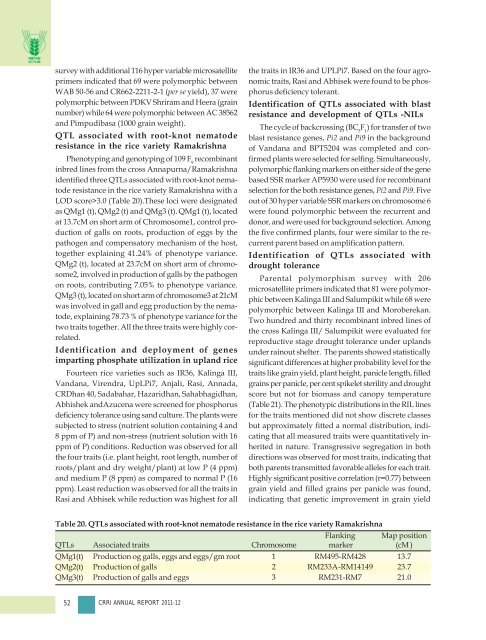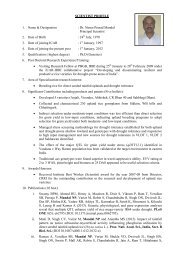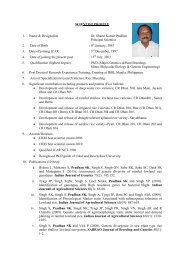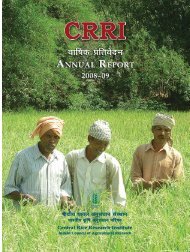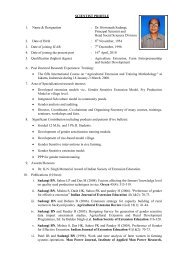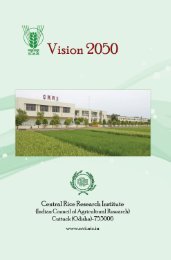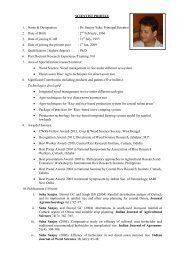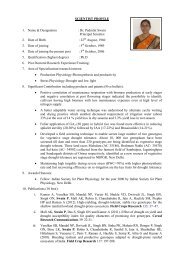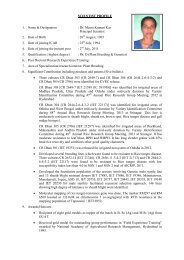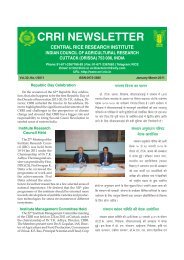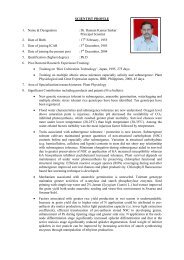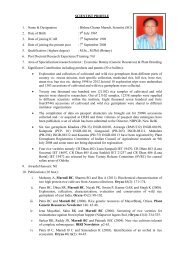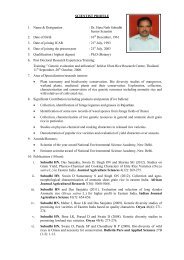Central Rice Research Institute Annual report...2011-12
Central Rice Research Institute Annual report...2011-12
Central Rice Research Institute Annual report...2011-12
You also want an ePaper? Increase the reach of your titles
YUMPU automatically turns print PDFs into web optimized ePapers that Google loves.
survey with additional 116 hyper variable microsatellite<br />
primers indicated that 69 were polymorphic between<br />
WAB 50-56 and CR662-2211-2-1 (per se yield), 37 were<br />
polymorphic between PDKV Shriram and Heera (grain<br />
number) while 64 were polymorphic between AC 38562<br />
and Pimpudibasa (1000 grain weight).<br />
QTL associated with root-knot nematode<br />
resistance in the rice variety Ramakrishna<br />
Phenotyping and genotyping of 109 F 9<br />
recombinant<br />
inbred lines from the cross Annapurna/Ramakrishna<br />
identified three QTLs associated with root-knot nematode<br />
resistance in the rice variety Ramakrishna with a<br />
LOD score>3.0 (Table 20).These loci were designated<br />
as QMg1 (t), QMg2 (t) and QMg3 (t). QMg1 (t), located<br />
at 13.7cM on short arm of Chromosome1, control production<br />
of galls on roots, production of eggs by the<br />
pathogen and compensatory mechanism of the host,<br />
together explaining 41.24% of phenotype variance.<br />
QMg2 (t), located at 23.7cM on short arm of chromosome2,<br />
involved in production of galls by the pathogen<br />
on roots, contributing 7.05% to phenotype variance.<br />
QMg3 (t), located on short arm of chromosome3 at 21cM<br />
was involved in gall and egg production by the nematode,<br />
explaining 78.73 % of phenotype variance for the<br />
two traits together. All the three traits were highly correlated.<br />
Identification and deployment of genes<br />
imparting phosphate utilization in upland rice<br />
Fourteen rice varieties such as IR36, Kalinga III,<br />
Vandana, Virendra, UpLPi7, Anjali, Rasi, Annada,<br />
CRDhan 40, Sadabahar, Hazaridhan, Sahabhagidhan,<br />
Abhishek andAzucena were screened for phosphorus<br />
deficiency tolerance using sand culture. The plants were<br />
subjected to stress (nutrient solution containing 4 and<br />
8 ppm of P) and non-stress (nutrient solution with 16<br />
ppm of P) conditions. Reduction was observed for all<br />
the four traits (i.e. plant height, root length, number of<br />
roots/plant and dry weight/plant) at low P (4 ppm)<br />
and medium P (8 ppm) as compared to normal P (16<br />
ppm). Least reduction was observed for all the traits in<br />
Rasi and Abhisek while reduction was highest for all<br />
the traits in IR36 and UPLPi7. Based on the four agronomic<br />
traits, Rasi and Abhisek were found to be phosphorus<br />
deficiency tolerant.<br />
Identification of QTLs associated with blast<br />
resistance and development of QTLs -NILs<br />
The cycle of backcrossing (BC 3<br />
F 1<br />
) for transfer of two<br />
blast resistance genes, Pi2 and Pi9 in the background<br />
of Vandana and BPT5204 was completed and confirmed<br />
plants were selected for selfing. Simultaneously,<br />
polymorphic flanking markers on either side of the gene<br />
based SSR marker AP5930 were used for recombinant<br />
selection for the both resistance genes, Pi2 and Pi9. Five<br />
out of 30 hyper variable SSR markers on chromosome 6<br />
were found polymorphic between the recurrent and<br />
donor, and were used for background selection. Among<br />
the five confirmed plants, four were similar to the recurrent<br />
parent based on amplification pattern.<br />
Identification of QTLs associated with<br />
drought tolerance<br />
Parental polymorphism survey with 206<br />
microsatellite primers indicated that 81 were polymorphic<br />
between Kalinga III and Salumpikit while 68 were<br />
polymorphic between Kalinga III and Moroberekan.<br />
Two hundred and thirty recombinant inbred lines of<br />
the cross Kalinga III/ Salumpikit were evaluated for<br />
reproductive stage drought tolerance under uplands<br />
under rainout shelter. The parents showed statistically<br />
significant differences at higher probability level for the<br />
traits like grain yield, plant height, panicle length, filled<br />
grains per panicle, per cent spikelet sterility and drought<br />
score but not for biomass and canopy temperature<br />
(Table 21). The phenotypic distributions in the RIL lines<br />
for the traits mentioned did not show discrete classes<br />
but approximately fitted a normal distribution, indicating<br />
that all measured traits were quantitatively inherited<br />
in nature. Transgressive segregation in both<br />
directions was observed for most traits, indicating that<br />
both parents transmitted favorable alleles for each trait.<br />
Highly significant positive correlation (r=0.77) between<br />
grain yield and filled grains per panicle was found,<br />
indicating that genetic improvement in grain yield<br />
Table 20. QTLs associated with root-knot nematode resistance in the rice variety Ramakrishna<br />
Flanking Map position<br />
QTLs Associated traits Chromosome marker (cM )<br />
QMg1(t) Production og galls, eggs and eggs/gm root 1 RM495-RM428 13.7<br />
QMg2(t) Production of galls 2 RM233A-RM14149 23.7<br />
QMg3(t) Production of galls and eggs 3 RM231-RM7 21.0<br />
52 CRRI ANNUAL REPORT 2011-<strong>12</strong>


